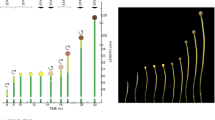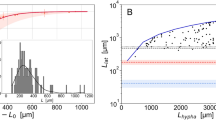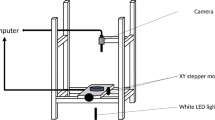Abstract
AN attempt was made some time ago1 to relate spiral growth in sporangiophores of Phycomyces to the physical properties of the wall, and the successful semi-quantitative test of the relation proposed against the data of Castle2, as well as the more recent extension to the case of spiral grain in conifers3, makes it reasonable to assume that, oversimplified though the relation undoubtedly is, it does express spiral growth in terms of the appropriate parameters. Assuming for simplicity that the ‘fibrils’ in the wall of the growth-zone are circular in section (though this is not an essential part of the theory) it appears that the rotation of the tip of the sporangiophore, Δφ, associated with a length increase of ΔL is given by the relation
This is a preview of subscription content, access via your institution
Access options
Subscribe to this journal
Receive 51 print issues and online access
$199.00 per year
only $3.90 per issue
Buy this article
- Purchase on Springer Link
- Instant access to full article PDF
Prices may be subject to local taxes which are calculated during checkout
Similar content being viewed by others
References
Preston, R. D., Biochim. et Biophys. Acta, 2, 155 (1948).
See, for example, Castle, E. S., Amer. J. Bot., 29, 654 (1942).
Preston, R. D., Forestry (in the press, 1949).
Author information
Authors and Affiliations
Rights and permissions
About this article
Cite this article
PRESTON, R., Middlebrook, M. Spiralling in Sporangiophores of Phycomyces Following a Temporary Cessation of Growth. Nature 164, 217–218 (1949). https://doi.org/10.1038/164217a0
Issue Date:
DOI: https://doi.org/10.1038/164217a0
This article is cited by
Comments
By submitting a comment you agree to abide by our Terms and Community Guidelines. If you find something abusive or that does not comply with our terms or guidelines please flag it as inappropriate.



